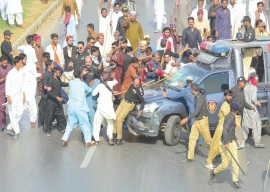
Ever since PTI began serious efforts to introduce Electronic Voting Machines (EVMs) in elections, the tool has come under criticism from the opposition parties. With Punjab aiming to embrace EVMs for the upcoming local government polls, the noise has further amplified. It is therefore important to objectively respond to some of the myths about electronic voting.
These myths relate to EVMs’ use around the globe, their cost, human resource capacity required to operate them, their vulnerability to hacking or misuse, their effectiveness in controlling electoral rigging and most importantly the motive of PTI behind introducing the idea.
The first myth around EVMs is that they are not popular around the world. This cannot be farther from the truth. EVMs are neither new nor based on untested technology. When considered the fact that EVMs are only critical for countries with democratic system of government and having large populations, one realises that EVMs are the dominant mode of polling used across large democracies worldwide. In fact, according to the Democracy Index, compiled by the Economist Intelligence Unit (EIU), there are 3.4 billion people around the globe who live in (either perfect or flawed) democracies. Looking across these democratic nations, it is easier to find out that over 2.6 billion or 75 per cent of these people live in countries that either use EVMs or are considering transition to paperless balloting in the near future. The largest democracies in the world include India, United States, Indonesia, Pakistan and Brazil, and with the exception of Pakistan and Indonesia, the rest use EVMs. Even Indonesia is now planning to adopt EVMs. PTI is moving with — not against — the global trend in election technology.
Then comes the myth about costs associated with EVMs. Without any objective analysis, some quarters have quoted exorbitant price tags to the tune of hundreds of billions of rupees, which is ridiculous. Let’s look at Indian example. Third generation EVMs in India are estimated to cost INR 17,000 or roughly PKR 40,000, which include a Control Unit, a Balloting Unit and a Voter Verified Paper Trail Unit. India deployed 1.8 million of these machines across roughly 1 million polling stations nationally, for the general elections of 2019. Pakistan would need roughly one-sixth of the volume or roughly 300,000 EVMs. With the same price tag as India, the required EVMs would roughly cost Rs12 billion. No amount of ‘related expenses’ or cost variation can increase this cost to hundreds of billions of rupees. Moreover, we should also take into consideration the savings attached to a more efficient and swift process. In case the election is held in phases, the cost to purchase EVMs could come down significantly.
The third myth is around the need of having IT experts with each EVM. EVMs would not require special IT expertise to operate and are actually quite simple to use for polling staff and voters. This needs perhaps far less IT literacy than operating a smartphone. We must remember that we live in a country with 106 million 3G/4G subscribers.
Another popular myth is that EVMs are easily hackable or prone to misuse. The EVMs being proposed in Pakistan are based on Voter Verified Paper Audit Trail (VVPAT), which means that the machine will give a printout to the voter, where he/she can clearly see his vote cast against his or her preferred candidate. These papers will be stored and available to serve as a paper audit trail, in case any controversy arises. Moreover, any inadvertent hacking would require some form of connectivity to the machine. The amendment in Election Act clearly mentions that the EVMs would be standalone machines, meaning thereby that these won’t have any connectivity to Internet or even through Bluetooth or Wifi. Many other IT safeguards have also been adopted by other countries to prevent foul play. Indian machines for instance are also standalone and any attempt to access memory is detected by an Unauthorized Access Detection Module which disables the device. Advanced encryption between the Control Unit, Balloting Unit and the VVPAT unit rules out the possibility of interfering in communications between these units through tapping. The software is burned onto a one-time programmable chip that cannot be tampered with. Since India introduced this technology, over 113 crore voters have cast their votes, with only 25 complaints received — all of them were found to be false.
Some people believe that EVMs are not effective against electoral rigging, which is not correct. According to Brookings Institute’s assessment of the Indian experience with EVMs, this technology has not only cut down electoral fraud and rigging but also reduced electoral violence and facilitated turnout among vulnerable groups, especially women. Within Pakistan, independent experts like Sarwar Bari have pointed out that EVMs would put an end to underhanded electioneering tactics that political parties have long depended on — ballot stuffing, tricking polling agents, post-electoral engineering enabled by unsealed polling bags, and delayed reporting of results.
Lastly comes the motive behind introducing EVMs. Interestingly PTI is not the first party to float this idea. In fact, EVMs were first piloted in a local government election in 2011 and then in by-election for an NA constituency in 2017, when the PPP and PML-N were in power, respectively. Incidentally, the ECP’s Strategic Plan for 2019-23 also commits to conducting “more pilot tests of electoral technologies [i.e. Electronic Voting Machine (EVM), Biometric Verification Machine (BVM) and Overseas Voting Mechanisms] to develop feasibility studies for operational and legal consideration by Parliament and other relevant authorities” and these reports were to be made available by December 2021 . It is therefore obvious that PTI is simply advancing an earlier reform and taking it to its logical conclusion.
It is time to close the door on an outdated election method that allows unethical and illegal electoral practices to flourish. PTI may be leading this effort but the ultimate beneficiary will not be any one political party but the 133 million voters of Pakistan.
Published in The Express Tribune, December 27th, 2021.
Like Opinion & Editorial on Facebook, follow @ETOpEd on Twitter to receive all updates on all our daily pieces.





















COMMENTS
Comments are moderated and generally will be posted if they are on-topic and not abusive.
For more information, please see our Comments FAQ